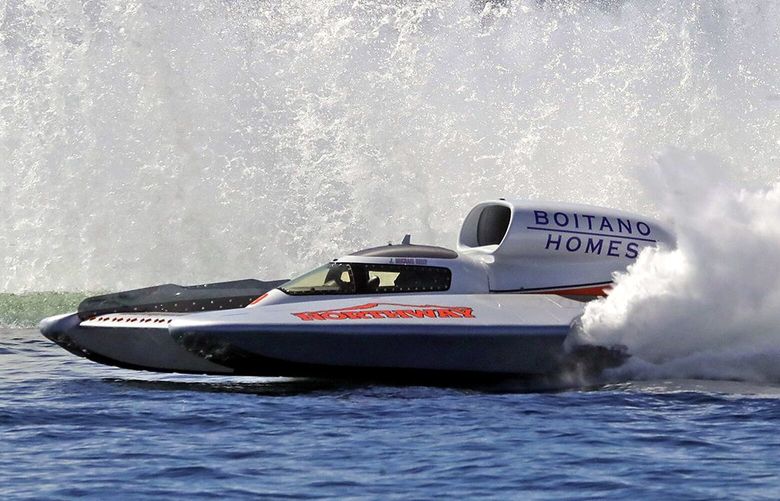Wait, you’ve never heard of the Gold Cup?
The oldest and longest continually contested trophy in motorsports?
Rings no bells?
The annual H1 Unlimited Hydroplane Racing Series’ biggest race, which is back in Seattle for the first time since 1985, is the reason all those people will be on the shores of Lake Washington this weekend. Without it, there’s no crowds, no Blue Angels, no thunder on the lake.
How is the Gold Cup responsible for all that? That story starts in Detroit in 1950. That was where the Gold Cup race was held that year, and a team from Seattle became the first boat from west of the Mississippi River to win it.
Owner Stan Sayres, driver/designer Ted Jones and builder Anchor Jensen surprised everybody in their Slo-Mo-Shun IV.
In those days, the winner of the Gold Cup got to host it the next year, and in 1951, the Gold Cup was held as part of new festival called Seafair, which had begun the year before. And the Gold Cup stayed on Lake Washington for the next five years as Sayres, who owned auto dealerships in Seattle, became the first to win the Gold Cup five consecutive times.
“There’s so much involved around Seafair,” said David Williams, executive director of the Hydroplane and Raceboat Museum in Kent. “And none of that would be here if it wasn’t for the Gold Cup.”
This weekend, those attending the race can view the unlimited hydroplanes in Stan Sayres pits and watch them circle the Ted Jones racecourse. And you can see the Slo-Mo-Shun IV at the Museum of History & Industry.
The Gold Cup turned a maritime community into one crazed for hydroplane racing. This was before the Sonics, Seahawks and Mariners captured sports fans’ hearts. The history books say the 1955 Gold Cup drew 500,000 fans. Seattle’s population was 420,000. All three local TV stations used to broadcast it. Kids pulled wooden hydroplanes behind their bikes.
Seattle fans knew the drivers, owners and crew chiefs like they know the Mariners’ starting rotation and the Seahawks’ backfield today.
“People in Seattle embraced the sport on a level that impossible to imagine unless you were here,” Williams said.
And all because couple of guys from Seattle won a boat race.
After the 1962 race, the format changed and the winner no longer hosted it the following year. The last time the Gold Cup was in Seattle was 1985 when Chip Hanauer won one of his record 11 Gold Cups in the Miller American.
In 1990, the Gold Cup found a home in Detroit until problems emerged with that race site. The Tri-Cities hosted it in 2015 before it returned to Detroit for three more years until the unlimited hydroplanes stopped racing on the Detroit River.
So why is it back this year?
Well, the Gold Cup is somewhat of a mercenary these days. It’s up to the sponsors. Bill Cahill, owner of Seattle-based Beacon Plumbing, has long been involved in hydroplane racing as a sponsor. Beacon Plumbing won a Gold Cup in 2006 when it sponsored Jean Theoret driving for then-owners Jane and Billy Schumacher, who earlier won two Gold Cups himself as a driver.
This season, Cahill is sponsoring Strong Racing, which is a two-boat team. The Beacon Plumbing boat is driven by Corey Peabody, who won the Gold Cup last year, and J.Michael Kelly, who won his own Gold Cup in 2016, drives the Beacon Electric boat.
“He’s such a big hydro fan,” said owner Darrell Strong, who approached Cahill with the idea. “It’s significant if you think about 38 years [since it’s been here].”
Besides its history, the Gold Cup is also the biggest race on the unlimited hydroplane calendar. For boats, it’s akin to the Indianapolis 500 or the Daytona 500.
“It’s the race that people will try harder and spend more [to win],” Williams said.
The Gold Cup trophy is sitting in the Strong Racing shop in Auburn. And that the team’s two drivers have their names on it is extra meaningful to Peabody.
“Two kids in the same neighborhood both have their names on it,” said Peabody, who grew up down the street from Kelly in Kent. “That’s pretty cool to me.”
Peabody won the Gold Cup in the season opener last year in Guntersville, Ala. It was the bright spot of the year for him, as he flipped the boat the next week in Madison, Ind., and was done for the season. This year he sits in first place in the seasonlong National High Points Standings.
This year’s Gold Cup, the 115th running, could be especially significant because it is the finale of a shorter-than-usual season (four races because San Diego Bayfair, the perennial season-ender, was a late scratch on the schedule due to sponsorship issues). That means in the final heat, the HomeStreet Bank Cup, the Gold Cup and the High Points National Championship could all be on the line.
With a deep field this year, there are plenty of contenders. The U-11 Unlimited Racing Group, which goes by Legend Yacht Transport this season, sits in third place despite not winning a race.
Claiming the first winner-take-all final in team history at the Gold Cup would reward years of hard work for owners Scott and Shannon Raney.
“You don’t want to take away the meaning of any race win, but it’s the pinnacle of everything we’ve done,” said Scott Raney, who was the crew chief in 2006 when the Beacon Plumbing won the Gold Cup.
The Gold Cup is more of an endurance race than the other stops on the H1 Unlimited Hydroplane Racing Series because it has four preliminary heats (one more than most races) to qualify for the final.
“Crazy things are going to happen over four heats of racing,” Raney said. “It always happens.”
History backs him up on that.
Gold Cup facts
- The Gold Cup was first held in 1904 on the Hudson River in New York and was won by Carl C. Riotte in the “Standard” at a speed of 23 mph.
- The cup trophy, originally called the Gold Challenge Cup, was designed by Tiffany & Co. and made of gold. It cost $750, according to a 1905 article in “The Motor Boat” magazine.
- The Gold Cup has been contested every year since 1946. The race wasn’t held during World War II.
- Chip Hanauer (11), Dave Villwock (10) and Bill Muncey (eight) have won the most Gold Cups. Those three are the top three in race wins and national titles.
- Bernie Little has the most Gold Cup wins as an owner, as his Miss Budweiser boats won 14.
- The 2001 movie “Madison” (starring Mount Vernon’s Jim Caviezel) was loosely based on the 1971 Gold Cup, which featured a true underdog story as the Miss Madison won in its home port of Madison, Ind.
- Andrew Tate is back competing at Seafair. He won the Gold Cup in 2018. His father, Mark Tate, won gold Cups in 1991 and 1994.
- Washington residents have won 47 Gold Cups.
- Of the seven people who have died in unlimited hydroplane racing, five were competing for the Gold Cup.
Source: Owen Blauman, longtime unlimited hydroplanes publicist
This version has been modified to fix an error on the name of the actor in “Madison.”


The opinions expressed in reader comments are those of the author only and do not reflect the opinions of The Seattle Times.